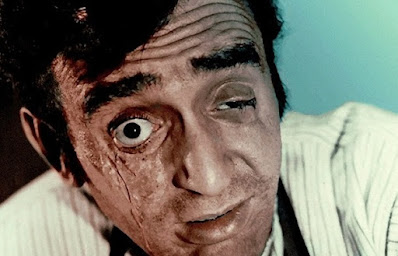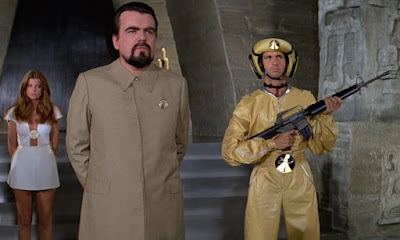THE SPY WHO LOVED ME (1977)
Nobody does it better; Roger Moore and Barbara Bach both give outstanding performances in this iconic Bond movie.
WHILE on a mission in Austria, Secret Agent James Bond 007 (Roger Moore) encounters a set of Russian operatives and kills Sergei Barsov (Michael Billington). Meanwhile, Allied and Soviet nuclear submarines are disappearing, so M (Bernard Lee) and his KGB counterpart General Gogol (Walter Gotell) assign 007 and leading Russian spy Major Anya Amasova (Barbara Bach) to work together and investigate. The leading suspect is reclusive Karl Stromberg (Curt Jurgens), a billionaire shipping magnate who has a unique operational base: Atlantis, a structure in the sea at the centre of his plans for a new aquatic world order. Bond and Amasova discover that Stromberg has been using his huge cargo ship Liparus to capture the submarines and imprison the crews, planning to use the subs to launch nuclear missiles to destroy civilisation. The two agents initially forge an uneasy alliance, which is further tested when Amasova realises that it was Bond who had murdered her lover, Barsov.
Freed from his strained relationship with Harry Saltzman, and following the lukewarm reception for THE MAN WITH THE GOLDEN GUN, Cubby Broccoli was determined to re-energise the Bond franchise. Yet the project was not a smooth ride: a disjointed script writing process - which had included the resurrection of SPECTRE and input of writers as diverse as Anthony Burgess and John Landis - was further shadowed by a court injunction obtained by Kevin McClory, who was attempting to remake THUNDERBALL. TV puppetmaster Gerry Anderson also instigated legal action when he discovered that some aspects of the script bore a resemblance to a MOONRAKER proposal he had submitted with UFO script editor Tony Barwick prior to DIAMONDS ARE FOREVER. Anderson was persuaded to drop the case, and rights were purchased by the producers.
A Steel-toothed character adapted from Ian Fleming's bad boy Horror, Richard Kiel's Jaws is one of the most recognisable Bond villains, but a missed opportunity. A nudging joke has the character bite and fight a shark at the end, but another less obvious tie-in is that JAWS director Steven Spielberg was approached to helm the picture, only to allegedly ask for too much creative control.
All this acts as problematic metaphors for Ian Fleming's novel The Spy Who Loved Me itself, the writer's most bizarre book. A total anomaly, it is written from the heroine's viewpoint, much of the action takes place in a motel room, and Bond himself doesn't appear until late on. Allegedly based on a true story, it was Fleming's intent to move away from the standard 007 format after criticisms of the Bond novels. After even greater disapproval, the author claimed at one point he just found the manuscript on his desk anyway. Consequently, when he sold the film rights of the books to Broccoli and Saltzman, Fleming specified that the source material was to be reinvented for the big screen and only the title could be used.
With a screenplay eventually in place - a combined effort credited to Richard Malbaum and Christopher Wood - production designer Ken Adam warned Broccoli that no sound stages in existence could accommodate the envisioned tanker battle climax; when Cubby simply instructed "then built it," it marked the creation of the famous 007 Stage at Pinewood, and also illustrated the kingpin's determination for the most spectacular Bond yet. Made for a then gargantuan $13.5m, THE SPY WHO LOVED ME contains exemplary Derek Meddings modelwork and is generally a visual stunner - filming major sequences in Egypt, Sardinia and the Bahamas - and unleashes the beautiful Lotus Esprit into the pantheon of extraordinary gadgets. The female cast are also particularly stunning - even the hotel receptionist is played by Valerie Leon - and Bach remains one of the most attractive lead women ever to grace a Bond film.

Veteran German actor Curt Jurgens as Stromberg. Underdeveloped and underplayed, the villain joins the ranks of Gustav Graves from DIE ANOTHER DAY, Brad Whitaker from THE LIVING DAYLIGHTS, and Elliot Carver from TOMORROW NEVER DIES as most ineffective menaces in the world of James Bond.
In essence a YOU ONLY LIVE TWICE remake, director Lewis Gilbert returns for what is widely regarded as the high mark to Moore's tenure, but there are issues. The comedic one liners still grate, and Marvin Hamlisch's dated score cheapens the action. But the main problem is Stromberg; a wet fish himself, Jurgens even has webbed fingers, which are never directly referred to. One of the dullest of Bond villains, he is another adversary who is reduced to pushing buttons and issuing ultimatums (his demise is also anticlimactic, providing a low key shootout). Even his rogues gallery are a mixed bag: dubbed by Barbara Jefford, Caroline Munro sizzles as helicopter assassin Naomi, Milton Reid's hulking henchmen Sandor is soon despatched, and the effectiveness of Richard Kiel's dim-witted but determined Jaws (in a role where David Prowse and Will Sampson were considered) is diluted by being increasingly used for light entertainment, an issue taken to another level for MOONRAKER.




























